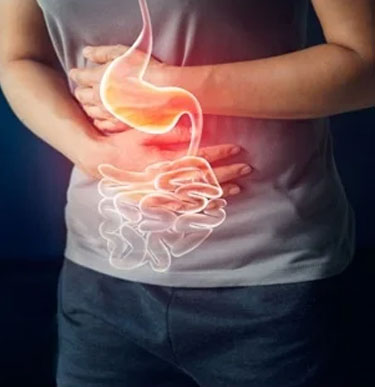Gastritis / Gastric Ulcers
Dr. Amit Miglani
Senior Gastroenterologist, Hepatologist & Endoscopist of Faridabad.
WHAT ARE GASTRIC ULCERS?
Introduction:
Gastric ulcers(GU) is a part of peptic ulcer disease and is one of the common GI disorders we encounter in our clinic practice. It can be defined as break in the mucosal lining of the stomach with a size ranging from 5 mm up to several cms with an appreciable depth on endoscopic examination and histologically penetration into submucosa.GU is one of the common cause of UGI Bleed which results in significant morbidity, mortality and health care costs. Gastric Ulcer is usually a benign disorder and can be prevented by appropriate measures and also can be treated with medical and endoscopic therapy.
Etiopathogenesis:
The most common cause of GU is bacterial infection with H.Pylori and NSAIDS use. Other less common causes include hypergastrinemia due to Zollinger Ellison Syndrome, malignancy, radiation, Crohn’s disease.
H.Pylori infection is associated with 65% to 70% of gastric ulcers. H.Pylori is a gram negative bacteria which resides in the gastric epithelial cells. It induces the inflammation in the gastric epithelial cells which results in degeneration of the gastric epithelium. It also damages the antral somatostatin secreting cells which leads to increased gastrin levels and secondary increased acid secretion leading to ulcer formation.
NSAIDS lead to inhibition of the prostaglandin secretion of the gastric mucosa due to inhibition of the Cyclooxygenase 1 enzyme which leads to decreased formation of mucoprotective prostaglandin. There is also alteration in the mucous and bicarbonate secretion in the gastric mucosa which leads to increased susceptibility for ulcer formation.
History and Physical examination:
Gastric Ulcer patients can be asymptomatic or symptomatic. Typical symptoms are upper abdominal pain or discomfort which is usually present in the epigastric region but can also occur in the right upper quadrant or left upper quadrant of abdomen. The pain can be sharp or burning which is aggravated with meals and relieved with fasting. It is usually non radiating but sometimes can radiate to the back if the ulcer is located posteriorly. Patients can also present with UGI bleed in the form of Coffee ground vomiting, black tarry stools or fresh blood in case of brisk upper GI bleed. Other symptoms can be dyspepsia, recurrent vomiting, weight loss, loss of appetite.
Physical examination in uncomplicated GU is usually normal however epigastric tenderness can be present.
DIAGNOSIS:
A thorough history and physical examination is must for patients suspected of GU.
Alarm features should be looked for which includes:
Iron deficiency anaemia, hematemesis, melena, stool occult blood positive, unintended significant weight loss, early satiety, persistent vomiting, palpable abdominal mass, left supraclavicular lymphadenopathy, new onset dyspepsia in elderly.
Diagnostic tests include complete blood counts, liver function tests and esophagogastroduodenoscopy (EGD). Endoscopy is the gold standard for the detection of gastric ulcers and can be helpful in both diagnostic and therapeutic procedures. During endoscopy ulcer location, size, number, depth and any stigmata of recent hemorrhage can be detected. Biopsies can be taken during endoscopy for detection of H.Pylori by rapid urease test followed by eradication of the organism if positive. Other tests for detection of H.Pylori are stool antigen test, urea breath test and serological tests. Urea breath test and stool antigen tests are non-invasive tests and are more helpful in eradication of H.Pylori after treatment.
Treatment:
Risk factors for GU should be identified and patients should be advised to stop NSAIDS, smoking and alcohol intake. For H.Pylori positive patients with gastric ulcer patients should undergo eradication of the organism and the eradication should be confirmed after 4 weeks of completion of therapy. There are various regimens available for treatment of H.Pylori however the local antibiotic resistance should be taken into consideration while starting H.Pylori treatment. Triple therapy is the first choice if the patient is not previously exposed to macrolides or if the resistance to clarithromycin is low. Bismuth quadruple therapy and concomitant therapy is preferred first line therapy . If the first line therapy fails then drug susceptibility testing should be done. If the drug susceptibility testing is not available then another regimen should be given which has previously not been used. If the bismuth therapy fails then salvage therapy with levofloxacin should be given. The duration of therapy should be given for 2 weeks which has been shown to have high eradication rates.90% of the Peptic ulcers heal by 2 weeks of eradication therapy with PPI and antibiotics however the PPI should be continued for 8 weeks in case of gastric ulcer healing. In patients with NSAID induced gastric ulcers, NSAIDS should be stopped if possible, however the patient should be switched to selective COX 2 inhibitors and continue with PPI where NSAIDS cannot be stopped.
Misoprostol is a prostaglandin E analogue which has been shown to stimulate mucus and bicarbonate secretion in the gastric epithelium.It is given in a dose of 200 micrograms four times daily for 8 weeks and also helps in reducing the deleterious effects of NSAIDS and aspirin on the gastric mucosa .Sucralfate coats the gastric mucosa and ulcer and also helps in stimulation of mucus,bicarbonate and prostaglandins in gastric mucosa which helps in ulcer healing.
Refractory ulcers:
An ulcer is considered to be refractory if it does not heal after 8 to 12 weeks of PPI theapy.In such conditions the other causes of GU should be ruled out like gastrinoma or malignancy, comorbidities. Surgical options for refractory GU are vagotomy and partial gastrectomy.

